
Welcome to the NWS Detroit/Pontiac Cooperative Observer Program (COOP) Website!
These pages were designed to highlight the important contributions of our cooperative observers and to provide access to the COOP data, and other sources of weather and climate data.
Weather data comes from a wide variety of sources, including satellite, remote sensors, radars, automated observing stations, and volunteer cooperative observers. Each and every day, a wide spectrum of users access these weather data to solve problems and plan their lives. Whether it is a farmer in Michigan, a climate scientist in Europe, or a weather enthusiast in New York, the weather data that our cooperative observers collect has a profound impact on society.
These pages were designed to help our customers access COOP and other sources of data, describe the uses of data, explain how to become an observer, and acknowledge our award winning COOP observers.
History of the NWS Cooperative Weather Program (COOP)
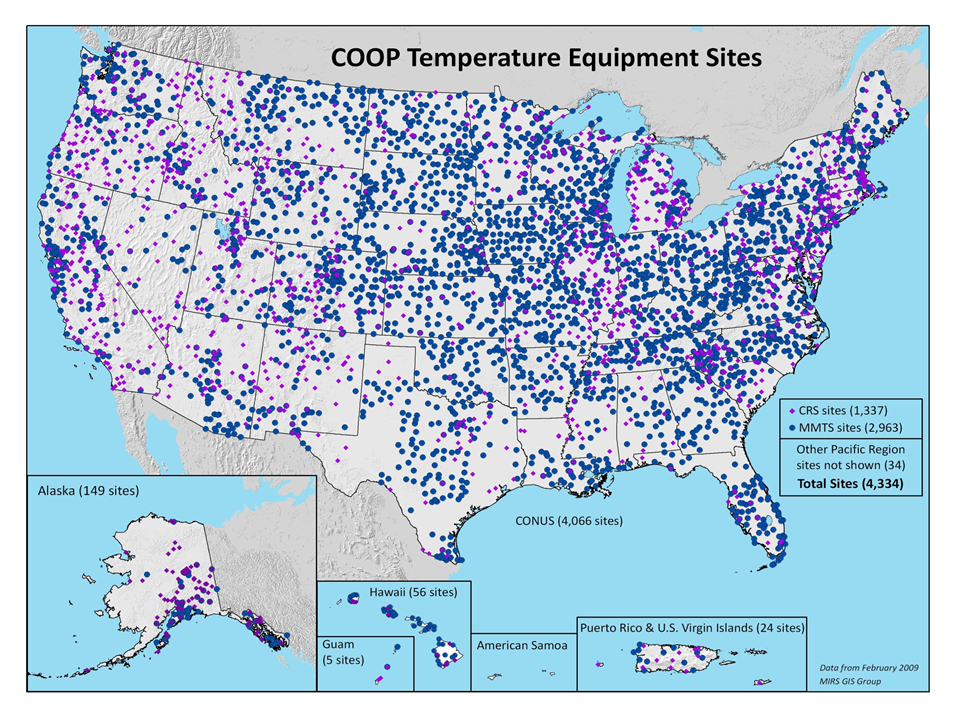 |
The National Weather Service (NWS) Cooperative Observer Program (COOP) is truly the Nation's weather and climate observing network of, by and for the people. More than 8,700 volunteers take observations on farms, in urban and suburban areas, National Parks, seashores, and mountaintops. The data are truly representative of where people live, work and play.
The Coop was formally created in 1890 under the Organic Act. Its mission is two-fold:
Coop observational data supports the NWS climate program and field operations. The program responsibilities include:
A cooperative station is a site where observations are taken or other services rendered by volunteers or contractors. Observers are not required to take any tests. Automatic observing stations are considered cooperative stations if their observed data are used for services which otherwise would be provided by cooperative observers. A cooperative station may be collocated with other types of observing stations such as standard observations stations, Flight Service Stations, etc. In these cases, that portion of the station observing program supporting the cooperative program's mission is treated and documented independently of the other observational and service programs.
Observers generally record temperature and precipitation daily and electronically send those reports daily to the NWS and the National Centers for Environmental Information (NCEI). Many cooperative observers provide additional hydrological or meteorological data, such as evaporation or soil temperatures. Data is transmitted via telephone, computer or, in special cases, by mail. Equipment used at NWS cooperative stations may be owned by the NWS, the observer, or by a company or other government agency, as long as it meets NWS equipment standards.
The first network of cooperative stations was set up as a result of an act of Congress in 1890 that established the Weather Bureau, but many Coop stations began operation long before that time. John Campanius Holm's weather records, taken without the benefit of instruments in 1644-45, were the earliest known observations in the United States. Subsequently many persons, including George Washington, Thomas Jefferson, and Benjamin Franklin, maintained weather records. Thomas Jefferson maintained an almost unbroken record of weather observations between 1776 and 1816, and George Washington took his last observation just a few days before he died.
Two of the most prestigious awards given to Cooperative Weather Observers are named after Holm and Jefferson. Because of its many decades of relatively stable operation, high station density, and high proportion of rural locations, the Cooperative Network has been recognized as the most definitive source of information on U.S. climate trends for temperature and precipitation. Cooperative stations form the core of the U.S. Historical Network (HCN) and the U.S. Reference Climate Network.
Volunteer weather observers conscientiously contribute their time so that observations can provide the vital information needed. These data are invaluable in learning more about the floods, droughts, heat and cold waves affecting us all. The data are also used in agricultural planning and assessment, engineering, environmental-impact assessment, utilities planning, and litigation. Coop data plays a critical role in efforts to recognize and evaluate the extent of human impacts on climate from local to global scales.
COOP Equipment Used
What equipment does a Cooperative Station use?
A cooperative weather observer uses different equipment dependent on the type of station they are at. Typically, and at a minimum, all observers have a rain gage with a few having a thermometer. Observing sites are placed in one or more of the following climate networks:
All sites play important roles in the daily operations of the National Weather Service.
Temperature Equipment
|
Cotton Region Shelter (CRS) |
Some COOP observers use the Cotton Region Shelter (CRS) to record maximum and Minimum temperature data. A CRS is typically a wooden structure with louvered sides, a slotted bottom and solid top. It is usually made of pine, painted white, and sits atop a wooden or metal base, 5 to 6 feet above the ground. Some shelters have an electric fan in it to allow for better circulation during light wind conditions. |
|
Alcohol (top) & Mercury (bottom) Thermometers in the CRS |
Thermometers used in a CRS are two basic types: Alcohol and Mercury. Alcohol thermometers are used to record the minimum temperatures. Minimum thermometers have a small bar embedded in the liquid which is pulled down the tube as the temperature falls. As the temperature warms again and the liquid moves back up the tube, the bar remains at the "minimum" which allows the observer to read the lowest temperature. Mercury thermometers are used to record the maximum temperature. Maximum thermometers have a small break near the base of the well of liquid at the bottom of the thermometer. So as the temperature falls from the high, this break in the liquid keeps the liquid in place at its high point. The observer then twirls the thermometers in a rack which rejoins the mercury or sends the bar back to the top of the liquid, resetting them for another days recording.
|
|
Maximum Minimum Temperature System (MMTS)
Nimbus Temperature Display |
The latest type of thermometer is the Maximum Minimum Temperature System (MMTS). A MMTS is an electronic thermometer not too different from the type you buy at the local electronics store. The MMTS is a thermistor housed in a shelter which looks similar to a bee hive. This design is similar in functionality to the CRS. Currently the MMTS requires a cable to connect the sensor with the Nimbus display. Future plans call for wireless devices which would eliminate many of the problems currently associated with the cabled systems. |
Precipitation Gauges
There are several types of gauges used but the COOP program uses two basic types:
|
Standard 8" Rain Gauge (SRG)
4" Plastic Rain Gauge (Photo courtesy of CoCoRaHS) |
The most common is the non-recording gauge called a Standard Rain Gauge (SRG). Typically the SRG is a metal cylinder with a funnel on top and a plastic measuring tube in the middle. The measuring tube can handle up to 2.00 inches of rain before overflowing into the larger outer cylinder. During the winter, the observer removes the funnel and inner tube and allows the snow to collect in the outer tube. The observer then melts the snow and measures it, getting an accurate water equivalent to report.
The CoCoRaHS program utilizes the 4 inch plastic rain gauge for precipitation recording. Information on the CoCoRaHS program can be found here. CoCoRaHS = Community Collaborative Rain, Hail & Snow Network |
|
Fischer Porter Rain Gauge (FPR) |
Another type of precipitation gauge is the recording gauge. The most common type is the Fisher Porter (F&P) gauge, developed by the Belfort instrument Company. It is also known as the Fischer Porter Rain Gauge (FPR). The FPR is designed to work for many years in remote and harsh environments. The FPR weighs the precipitation it collects in a large metal bucket. This bucket sits atop a mechanism which converts the weight of the water into the measuring unit of inches and then, every 15 minutes, records the amount of precipitation. In the winter months the bucket is filled with anti-freeze which allows snow and ice to melt and be accurately measured. The observer downloads the data once a month and sends it to the local NWS Office. After reviewing the data, the local NWS office sends it to the National Centers for Environmental Information (NCEI) for archiving.
|
Cellular Cooperative Observation Program (CCOOP)
|
CCOOP |
The latest solution to modernize the National COOP network, is the implementation of a Cellular Cooperative Observation Program (CCOOP). The CCOOP utilizes both the MMTS & FPR systems to remotely upload the observational data via a cellular modem. This allows the observations to be taken automatically with minimal contact. |
Snowfall and Snow Depth
|
Snowboard |
Observers also report the amount of snow and the snow depth of newly fallen and existing snow. This can be a difficult task, especially in windy conditions. Observers must use experience and the guidelines provided by the NWS.
Snow depth is defined as the average depth of total snow on the ground in the representative measurement area. Unlike, snowfall measurement, snow depth is rounded to the nearest whole inch (example: 1" or 8"). |
Communicating the Observations to the NWS Office
There are several methods available to the COOP observer to send data to the NWS. Some observers call information to the office using a toll free number. Others use a programmable telephone or a PC based program. The newest and most preferred method is via a web based reporting system called WxCoder. All the observer provided data is coded in a special format which NWS computers can read and decipher, allowing the viewing of this data both graphically and in a tabular format.
The COOP observer plays an extremely important part in the role of the National Weather Service. The data they collect are used in a wide variety of applications: agriculture, industry, city planning, litigation, and studies about long term climatological events such as El Nino and La Nina.
COOP observers are truly unsung heros whose dedication needs to be celebrated and their efforts sung from the heights.
COOP Awards
National COOP awards can be viewed through the Cooperative Observer Newsletter (1982 to present)
There are different types of awards that are available to cooperative observers and institutions based on both length of observations and quality of service. There are Length of Sevice (LoS), Institutional and Special Service awards. Institutions include schools, power stations, Corps of Engineer dams, local governments, and other entities, where an individual is not identified as the observer. Often, whomever is working at observation time will record the data. Institutions shall receive an award for each 25 years of service. Special Service awards are presented from a local level, and may be given for any reason that is appropriate. This may include recognition for an individual who has been the primary observer for many years at an institution, and otherwise would not be officially recognized.
Individual Cooperative Observer Awards
Length of Service (LoS) Awards are given to individual cooperative observers after 10 years of service and every 5 years thereafter. Two of the more prestigious awards are the Thomas Jefferson award and the John Campanius Holm award. Both were created in 1959 for the National Weather Service to honor cooperative weather observers, and the first of each was presented in 1960. To be eligible for these awards, observers' excellence must include accuracy, promptness, legibility, cooperation, consistency and care of equipment. These things must have been done over a long period of time.
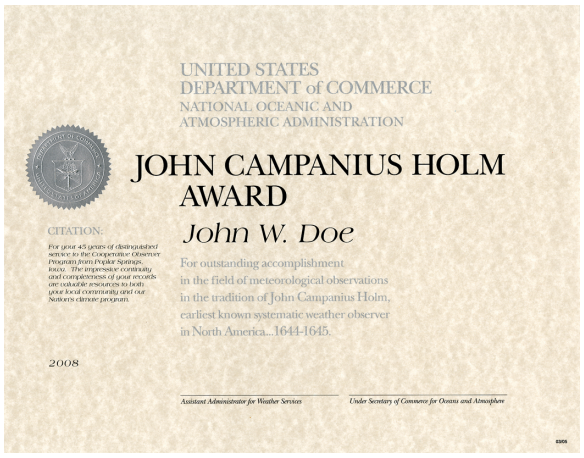 |
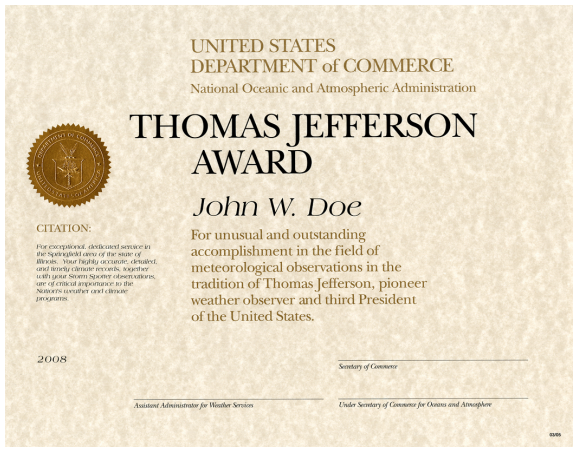 |
|
Figure 1: John Campanius Holm Award This award is to honor cooperative observers for outstanding accomplishments in the field of meteorological observations. It is named for a Lutheran minister, the first person known to have taken systematic weather observations in the American Colonies. Reverend Holm made observations of climate without the use of instruments in 1644 and 1645, near the present site of Wilmington, Delaware. No more than twenty-five Holm awards are given annually. |
Figure 2: Thomas Jefferson Award This award was named in honor of Thomas Jefferson, our third President, who kept an almost unbroken series of weather records from 1776 to 1816. The Thomas Jefferson Award is the most prestigious award a cooperative observer can receive. Five cooperative observers are honored each year with the Jefferson Award for outstanding and distinctive achievements. All candidates for the Jefferson Award are required to have been a recipient of the Holm Award five or more years before the year the nomination form is submitted for the Jefferson Award. |
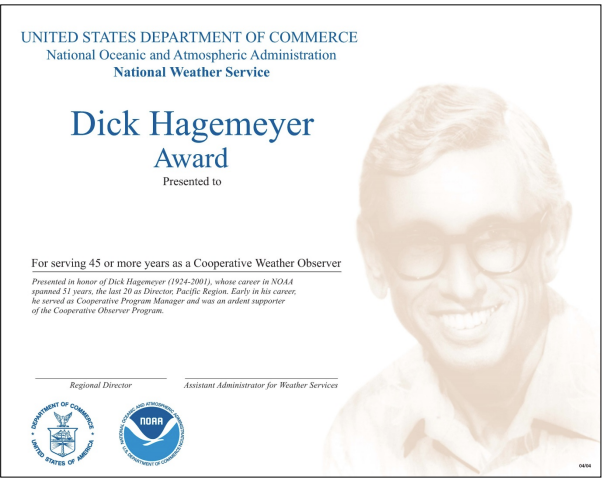 |
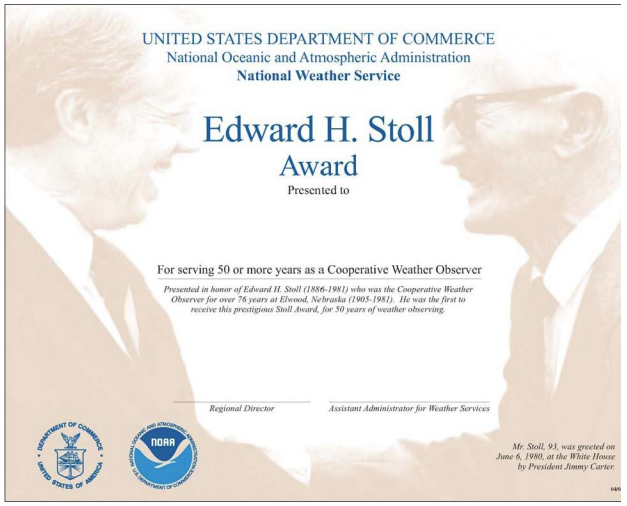 |
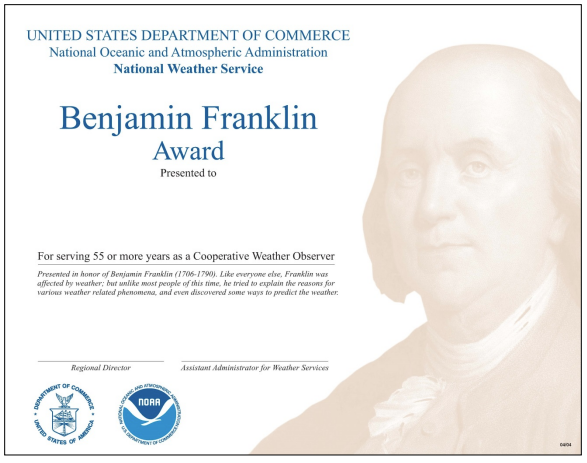 |
|
Figure 3: Dick Hagemeyer Award This award was established in honor of Dick Hagemeyer (1924-2001) whose career spanned 51 years with NOAA and his last 20 years were served as Director of the NWS Pacific Region. Prior to this position, he served as a Substation Network Specialist/ Cooperative Program Manager. This award is granted to an observer for 45 years of service. |
Figure 4: Edward H. Stoll Award This award was created and became effective in 1975 in honor of Mr. Edward H. Stoll. Mr. Stoll was the observer at Elwood, Nebraska for over 76 years and was the first to receive the prestigious Stoll award. To receive this award, an observer must have taken observations for 50 years. |
Figure 5: Benjamin Franklin Award This award was established in honor of Benjamin Franklin (1706-1790) who invented the lightning rod and was one of the first to describe the movement of large storm systems. As Postmaster General, he received weather reports from a network of observers along the coast. The reports are the first known record of hurricanes having been systematically tracked. This award is granted to an observer for 55 years of service. |
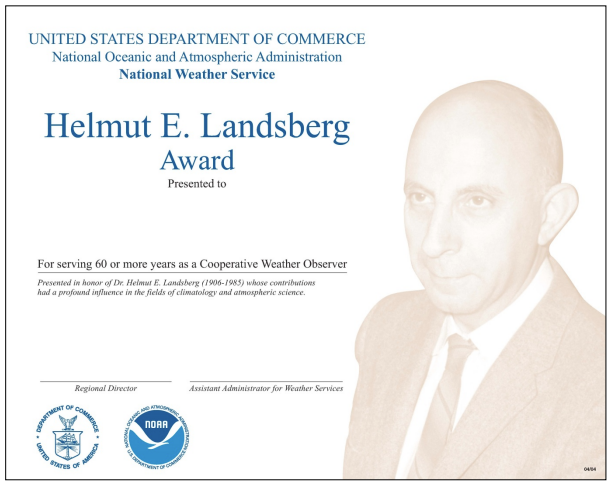 |
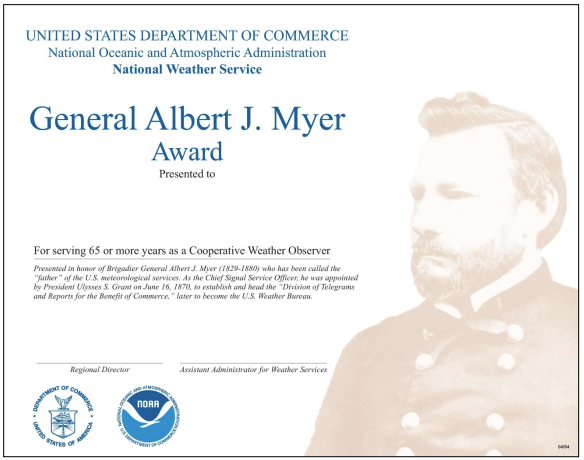 |
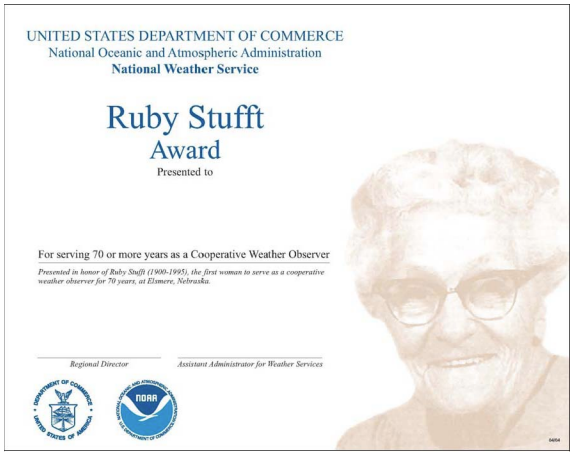 |
|
Figure 6: Helmut E. Landsberg This award was created in 1986 in honor of Dr. Helmut E. Landsberg, one of the preeminent climatologists of our time. This award is presented to all observer who have completed 60 years of service as cooperative observers. |
Figure 7: General Albert J. Myer Award The award was named after an observer at Eagle Pass, Texas. In 1870 Mr. Meyer was appointed to establish and direct the "Division of Telegrams and Reports for the Benefit of Commerce," now known as the NWS. Anyone who serves as an observer for 65 years is eligible for this award. |
Figure 8: Ruby Stufft Award In 1991, Mrs. Ruby Stufft of Elsmere, Nebraska, completed 70 years as a cooperative observer. This award was named in her honor, and is presented to any observer attaining 70 years of service. |
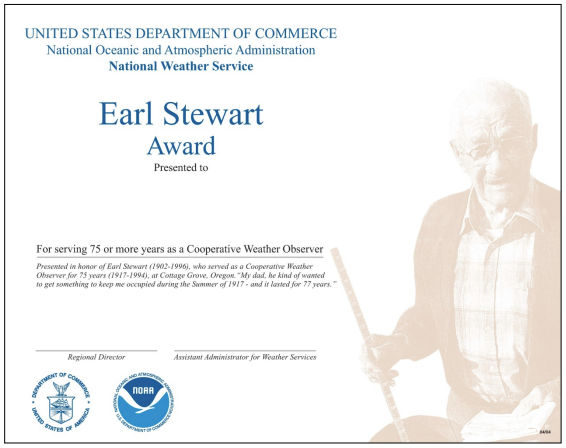 |
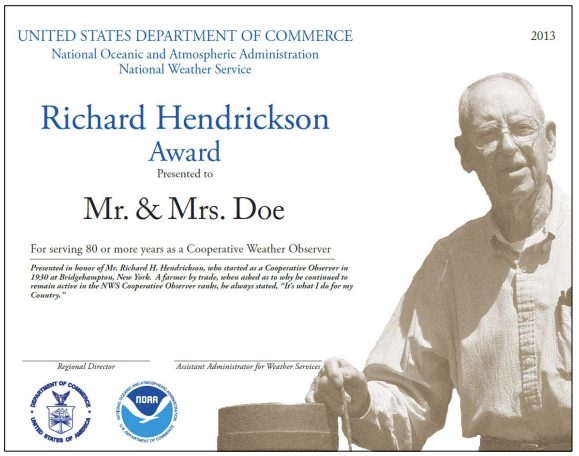 |
|
|
Figure 9:Earl Stewart Award This award was named for an observer in Cottage Grove, Oregon. Mr. Stewart completed 75 years of continuous observations in 1992. The criterion for this award is that an observer serve the NWS as an observer for a period of 75 years or more. |
Figure 10: Richard Hendrickson Award This award was established in honor of Richard Hendrickson. Mr. Hendrickson completed 80 years of continuous observations at Bridgehampton, New York, in 2010. He continued his work into 2015 as a primary observer until he retired at age 103. Observers receive this award after 80 years of observations. |
|
Data, Records & Sources
For our local users in Southeast Michigan, some data sets are available on the local Climate and Past Weather section. Our climate page also contains daily and monthly climate reports for Detroit, Flint and Saginaw. A variety of products for many sites across Michigan can be accessed via the NOWData page.
Monthly normals, climate records, top 20 lists and more for Southeast Michigan can be found our Local Climate Data Page under the tab Local Data/Records.
National snow analyses can be found at the National Operational Hydrologic Remote Sensing Center (NOHRSC).
The following links are to the Midwestern Regional Climate Center (MRCC) Midwest Climate Watch, which is an entry point to a wealth of current information on the Midwest. The Midwest Climate Watch includes daily, 7-day, 30-day, and month-to-date maps of temperature, precipitation, snowfall, snow depth, and growing degree days, as well as maps for prior months and seasons
Certified Weather & Climate Data
The National Centers for Environmental Information (NCEI) is the official repository of NWS data and the world’s largest archive of an extensive range of weather and climate data. All certified data must be obtained directly from NCEI. NCEI archives 99% of all NOAA data and makes it available in a number of formats. Climatological publications are available as well.
More information about data certification and costs can be found here.
Southeast Michigan's COOP Program
|
|
|
***Coming Soon***
|
Interested in the COOP Program?
The weather observers who make up the Cooperative Observer Program are a core of volunteers numbering over 11,000 people across the country. This all volunteer network of weather observers has become an American institution. The program and its history of success continue to arouse the envy of other countries around the globe and has been acclaimed as the most cost-effective weather data collection network in the world.
The Cooperative Observer Network operates basically as it did the first year of its inception over 100 years ago. This data has become more valuable with time as the data now forms the cornerstone of the Nation's climatological history. Cooperative Weather Observers come from all walks of life, even water and pollution control plants, schools, as well as many local and state government offices are all among those contributing to the program.
The Cooperative Observing Program mission is two-fold. It provides daily maximum and minimum temperatures, 24 hour precipitation and snowfall totals and then provides this data in near real-time to support forecast, warning and other public service programs of NOAA's National Weather Service.
Equipment to gather this data is provided by NOAA's National Weather Service and maintained by the Cooperative Program Manager. The data that is sent to your local weather service office is quality controlled, then sent to the National Centers for Environmental Information in Asheville, North Carolina; where the data is archived.
Becoming a NOAA's National Weather Service Cooperative Observer volunteer requires the following:
If you are interested in becoming an Official Cooperative Weather Observer for your area in Southeast Michigan, please contact the NWS Detroit/Pontiac, MI office at: w-dtx.webmaster@noaa.gov
|
Wanted: COOP Observers |
|
From time to time, we will reach out for COOP observers in certain areas. Any immediate openings will be listed below. |
 |
Media use of NWS Web News Stories is encouraged! Please acknowledge the NWS as the source of any news information accessed from this site. |
 |